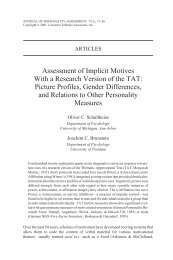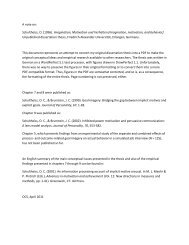Oliver C. Schultheiss, Dr. phil. Professor of Psychology
Oliver C. Schultheiss, Dr. phil. Professor of Psychology
Oliver C. Schultheiss, Dr. phil. Professor of Psychology
You also want an ePaper? Increase the reach of your titles
YUMPU automatically turns print PDFs into web optimized ePapers that Google loves.
Curriculum Vitae: <strong>Oliver</strong> C. <strong>Schultheiss</strong> 5<br />
Karabenick (Eds.), Advances in motivation and achievement (Vol. 16a: The decade<br />
ahead: Theoretical perspectives on motivation and achievement, pp. 199-233).<br />
Bingley: Emerald.<br />
50. Liening, S. H., Stanton, S. J., Saini, E. K., & <strong>Schultheiss</strong>, O. C. (2010). Salivary<br />
testosterone, cortisol, and progesterone: two-week stability, interhormone<br />
correlations, and effects <strong>of</strong> time <strong>of</strong> day, menstrual cycle, and oral contraceptive use<br />
on steroid hormone levels. Physiology and Behavior, 99(1), 8-16.<br />
49. <strong>Schultheiss</strong>, O. C., & Brunstein, J. C. (2010). Introduction. In O. C. <strong>Schultheiss</strong> & J.<br />
C. Brunstein (Eds.), Implicit motives pp. ix-xxviii). New York, NY: Oxford University<br />
Press.<br />
48. Hall, J. L., Stanton, S. J., & <strong>Schultheiss</strong>, O. C. (2010). Biopsychological correlates <strong>of</strong><br />
implicit motives. In <strong>Schultheiss</strong>, O. C., & Brunstein, J. C. (Eds.), Implicit motives (pp.<br />
279-307). New York: Oxford University Press.<br />
47. Stanton, S. J., Hall, J. L., & <strong>Schultheiss</strong>, O. C. (2010). Properties <strong>of</strong> motive-specific<br />
incentives. In <strong>Schultheiss</strong>, O. C., & Brunstein, J. C. (Eds.), Implicit motives (pp. 245-<br />
278). New York: Oxford University Press.<br />
46. Stanton, S. J., & <strong>Schultheiss</strong>, O. C. (2009). The hormonal correlates <strong>of</strong> implicit power<br />
motivation. Journal <strong>of</strong> Research in Personality, 43, 942-949.<br />
45. Brown, S. L., Fredrickson, B. L., Wirth, M. M., Poulin, M. J., Meier, E. A., Heaphy, E.<br />
D., Cohen, M. D., & <strong>Schultheiss</strong>, O. C. (2009). Social closeness increases salivary<br />
progesterone in humans. Hormones and Behavior, 56, 108-111.<br />
44. Stanton, S. J., Wirth, M. M., Waugh, C. E., & <strong>Schultheiss</strong>, O. C. (2009). Endogenous<br />
testosterone levels are associated with amygdala and ventromedial prefrontal cortex<br />
responses to anger faces in men but not women. Biological <strong>Psychology</strong>, 81, 118-122.<br />
43. <strong>Schultheiss</strong>, O. C., Riebel, K., & Jones, N. M. (2009). Activity inhibition: A predictor <strong>of</strong><br />
lateralized brain function during stress? Neuropsychology, 23, 392-404.<br />
42. <strong>Schultheiss</strong>, O. C., Kordik, A., Kullmann, J. S., Rawolle, M., & Rösch, A. G. (2009).<br />
Motivation as a natural linchpin between person and situation. Journal <strong>of</strong> Research in<br />
Personality, 43, 268-269.<br />
41. <strong>Schultheiss</strong>, O. C., & Stanton, S. J. (2009). Assessment <strong>of</strong> salivary hormones. In E.<br />
Harmon-Jones & J. Beer (Eds.), Methods in the neurobiology <strong>of</strong> social and<br />
personality psychology (pp. 17-44). New York, NY: Guilford.<br />
40. <strong>Schultheiss</strong>, O. C., Yankova, D., Dirlikov, B., & Schad, D. (2009). Are implicit and<br />
explicit motive measures statistically independent? A fair and balanced test using the





